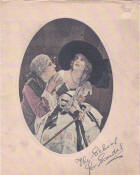The School
for Scandal
|
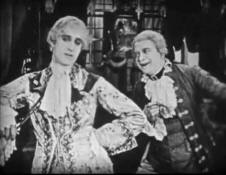 Rathbone (as Joseph) with Sir Peter Teazle |
 Joseph with Sir Peter Teazle and Mrs. Candour |
Sir Oliver first visits Charles, where a drinking and gambling party is in progress. Sir Oliver claims to be Mr. Premium, a man who can supply the money that Charles needs. Charles has sold most of his possessions, except for the portraits of his ancestors, which he now attempts to sell to "Mr. Premium." Mr. Premium agrees to buy the paintings, and is impressed that Charles refuses to part with the portrait of his uncle, Sir Oliver. Despite having many pressing debts of his own to pay, when Charles receives the money for the portraits, he sends a portion to "Mr. Stanley," a poor relative whose financial circumstances are even worse than his own. This shows that Charles is generous and compassionate.
To test Joseph’s alleged morality, Sir Oliver visits his older nephew disguised as "Mr. Stanley," the poor relative who needs charity. Joseph gives him nothing and even goes so far as to say that he has not received the fortune from Sir Oliver that he is reputed to have. Joseph’s true character shows through, as he lies and fails to show generosity to a poor relative.
Joseph conspires with Lady Sneerwell to prevent an engagement between his brother and Maria whom he wants to marry for her money. At the same time, he is trying to seduce Lady Teazle, who has been considering becoming his lover in order to be "fashionable." Lady Teazle visits Joseph at his house.
The school for scandal has spread the rumor that Lady Teazle and Charles Surface are having an affair. When Sir Peter learns of this, he heads to Joseph's house to talk to him about his brother. Terrified of being discovered, Lady Teazle hides behind a screen as Sir Peter makes his way up Joseph's stairs. Sir Peter confides in Joseph that he is worried his wife is having an affair with Charles. When Sir Peter begins to discuss Joseph’s desire to wed Maria, Lady Teazle realizes that Joseph has been deceiving her.
 Basil Rathbone as Joseph |
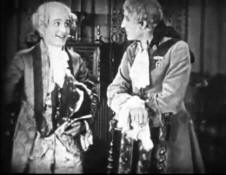 Charles and Joseph Surface |
Next, Charles arrives at Joseph’s house, and Sir Peter hides in a closet to eavesdrop on Joseph and Charles’s conversation and to discover whether Charles is Lady Teazle’s lover. When Joseph asks his brother about Lady Teazle, Charles denies any involvement with her. Sir Peter comes out from hiding and tells Charles he is very relieved. Sir Peter and Charles notice the feet visible below the screen. The screen is removed, revealing Lady Teazle. She tells her husband the truth—that she was considering having an affair with Joseph, but nothing happened. Sir Peter forgives her and the Teazles are reconciled.
The final scene takes place at Joseph's house, and the man that the Surface brothers thought was Mr. Premium or Mr. Stanley is revealed to be Uncle Oliver. Joseph tries to make excuses for his behavior, but Charles only apologizes for having disrespected the family by selling the portraits. Sir Oliver tells Charles he forgives him everything and Joseph that he sees through his hypocrisy. The play ends with an engagement between Maria and Charles, who will be his uncle’s sole heir.
| The School for Scandal ... is certainly
lovely to look at and the costuming is particularly fine, with the
characters looking as though they go about their daily lives in the
clothes they wear. The costumes are not costumey, is my point.
Director Bertram Philips adds a few clever visual touches, such as
Joseph scheming during a dance performance that mimics marionettes. The performances range from understated to just a little hammy, with Rathbone on the more subtle side of the equation. Billie Shotter isn’t called on to do much more than stand around and look pretty. Queenie Thomas is given a bit more to do as Lady Teazle, ... [and] Scottish actor John Stuart, who plays Charles, is a bit too merry in his part. ... Basil Rathbone’s subtle performance may have used just a dash of oomph but he generally acquits himself very well. —Fritzi Kramer, Movies Silently |
Filming for The School for Scandal began in June and was completed in August 1923. The September 9, 1923, issue of The Film Daily announced that Butcher's Film Service will distribute the film.
According to the Internet Movie Database, The School for Scandal was released in London September 1923, and in the rest of the United Kingdom February 4, 1924. The reason for the delay is unknown. It may have been delayed to avoid confusion with another version of The School for Scandal that was filmed in 1923. That version is part of a series of short films called Gems of Literature. See https://www.imdb.com/title/tt0212486/?ref_=tttr_tr_tt
 Charles, Sir Peter, and Joseph |
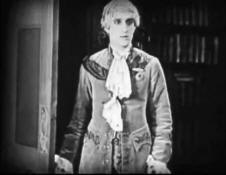 Joseph Surface |
What about release in the USA? On November 8, 1923, the film was previewed at Columbia University in New York City. The audience included about 400 Columbia University alumni: businessmen, professors, scientists, and other prominent and distinguished alumni. Although some of them complained about the subtitles being "jazzed-up" versions of the lines from Sheridan's masterpiece, most of them loved the film. They laughed out loud. —The Film Daily, November 14, 1923
| The reviews and comments were mixed. Kine Weekly decided that Phillips had
managed to make a fairly entertaining picture but had not reproduced the
comedy. ... However, further criticism
was harsh with comments like the settings were unremarkable, the
continuity scrappy, the action jerky and harsh and the lighting uneven. In complete contrast, Bioscope thought that the settings were elaborate and the technical quality of a high order. Motion Picture Studio thought that it was the best picture Phillips had given and that he had done a good job saying it was credible and ‘very reasonably faithful to the original….a pleasant, interesting and often amusing picture.’ They were also full of praise for the art direction. ... The casting was commendable because of the variation of the personalities all of whom were regarded as interesting and none colourless. ... Oddly, one critic thought Basil Rathbone was splendid, another that he was badly cast. —Jazz Age Club, http://www.jazzageclub.com/film/the-school-for-scandal-1923/ |
"An entertaining screen version of a famous 'screen' play." —Pictures and Picturegoer, February 1924
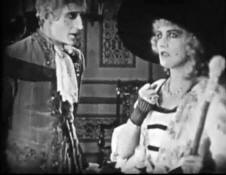 Joseph and Lady Teazle |
 Richard Sheridan, playwright |
The original film was 1,935 meters long, which corresponds to approximately 6 reels (about 60 minutes). The film is apparently lost, but an abridged version that's nearly 10 minutes long was released to the public, and thanks to a collector named Christopher Bird, Rathbone fans have the opportunity to see Basil Rathbone in this early silent film! This abridged version features the famous "screen" scene. You can see the short film below. You can also watch it and download it here: https://archive.org/details/TheSchoolForScandalBasilRathbone1923
.
|








